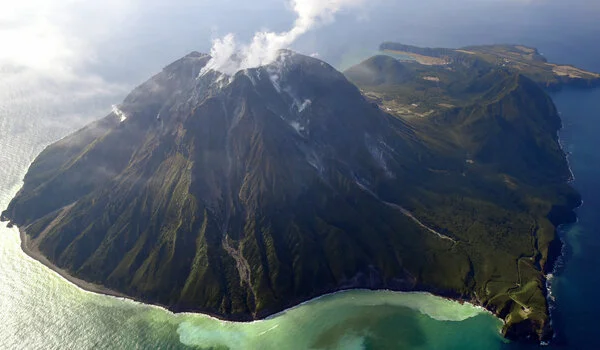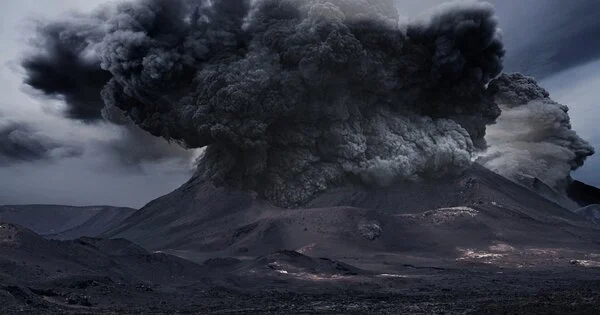The Aleutian-Alaska Arc is a volcanic arc located in the Pacific Ring of Fire’s northernmost region. It stretches over 3,000 kilometres from the Alaska Peninsula to the Aleutian Islands and is known for its dense concentration of active volcanoes. Scientific research has been conducted on these volcanoes in order to better understand their environmental impact, including the release of carbon dioxide (CO2) gas.
Scientists have long wondered what happens to the organic and inorganic carbon that Earth’s Pacific Plate transports into the planet’s interior as it moves along the volcano-studded Ring of Fire. According to a new study, a significant amount of such subducted carbon returns to the atmosphere rather than travelling deep into the Earth’s mantle.
The finding can improve long-term projections about Earth’s climate.
According to a study led by a University of Alaska Fairbanks Geophysical Institute scientist, the Aleutian-Alaska Arc volcanoes return more subducted slab carbon to the atmosphere as carbon dioxide than previously thought. This is accomplished through the recycling process.
Taryn Lopez, a research associate professor, is the lead author on a study published today in the journal Science Advances. The 12 co-authors are from California, New Mexico, New York, Rhode Island, Washington, D.C., as well as Italy and New Zealand.
From the Alaska Peninsula west, we know that the overriding crust does not have a substantial amount of carbon. So that means we can assume that the carbon degassing from volcanoes comes from either the mantle or the subducted slab.
Taryn Lopez
“While we now have a fairly good idea of how much carbon is driven into the Earth’s interior through subduction and how much is released to the atmosphere by volcanoes, there is still a lot to learn about what happens to the carbon after it is subducted and what fraction is returned to the atmosphere,” Lopez said.
The Aleutian-Alaska Arc, which extends from Cook Inlet west across the Aleutian Islands, has fewer carbon sources in its crust and subducted slab than most volcanic arcs on the planet. This allows researchers to follow carbon through the subduction cycle and gain a better understanding of how much-subducted carbon volcanoes return to the atmosphere.
Carbon recycled to arc volcanoes (those located above an oceanic plate subduction zone) comes from three different sources: the subducted oceanic plate or slab, the mantle wedge overlying the descending slab, and the overriding crust. Lopez wanted to know how much carbon is coming from the subducted slab.
Organic carbon settles on the seafloor, which is the surface of the oceanic crust slab on its way to subduction. Organic carbon consists of marine plant and animal remains as well as terrestrial plant and animal remains washed into the ocean. Seawater-derived inorganic carbon can precipitate as minerals onto the slab of the oceanic crust.

Lopez and colleagues collected gas samples from 17 volcanoes during this and previous research. They analysed data from four ocean drill cores taken near the Aleutian Trench, where the Pacific Plate dives beneath the North American Plate.
Using this data, the researchers used chemical modelling to determine how much organic and inorganic carbon returns to the atmosphere from the subducted slab at the Aleutian Trench. Carbon was tracked from subduction to volcano outgassing. The study concentrated on the central and western regions of the Aleutian-Alaska Arc, which are made up of oceanic crust.
“From the Alaska Peninsula west, we know that the overriding crust does not have a substantial amount of carbon,” Lopez said. “So that means we can assume that the carbon degassing from volcanoes comes from either the mantle or the subducted slab.”
Lopez and her colleagues began looking for the proportion of carbon 12 and 13 atoms in the gas coming from volcanoes. The carbon 12 isotope constitutes nearly 99% of Earth’s carbon. The carbon 13 isotope, which has an additional neutron in its nucleus, makes up only about 1%. Inorganic carbon, organic carbon and mantle carbon all have somewhat distinct proportions of the two isotopes.
The team determined the isotopic composition and total amount of carbon entering the trench from the subducted slab, as well as the average carbon isotopic composition of the volcanic gases. Using that data, they calculated the amount of subducted carbon released into the atmosphere as a result of the degassing of Aleutian-Alaska Arc volcanoes.
Previous research concluded that only trace amounts of organic carbon in ocean floor sediments and inorganic carbon from the subducted slab crust were released into the atmosphere. Lopez and colleagues discovered that volcanic degassing in the central Aleutians returns approximately 43% to 61% of sediment-derived organic carbon to the atmosphere and that degassing of western Aleutian volcanoes returns approximately 6% to 9% of inorganic carbon from the slab crust to the atmosphere.
The researchers also discovered that the proportions of organic and inorganic carbon recycled through arc volcanoes appeared to be influenced by subduction zone characteristics such as subduction speed and slab temperature.
“These results indicate that less carbon is returned to the deep mantle than we previously thought,” Lopez said. “These findings help to clarify our understanding of the fate of subducted carbon and may aid in the improvement of global climate models.”





